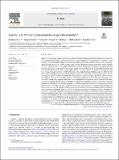Apatite : a U-Pb thermochronometer or geochronometer?
Abstract
Apatite is an accessory mineral that is frequently found in both igneous and clastic sedimentary rocks. It is conventionally considered to be characterized by a closure temperature range between 375 and 600 °C and hence has been employed to address mid-temperature thermochronology questions relevant to the reconstruction of thermal events in the middle to lower crust. However, questions remain as to whether apatite faithfully records thermally-activated volume diffusion profiles, or rather is influenced by recrystallization and new growth processes. We present a case study of two apatite samples from the Akia Terrane in Greenland that help chart some of the post magmatic history of this region. Apatite in a tonalitic gneiss has distinct U-enriched rims and its U-Pb apparent ages correlate with Mn chemistry, with a high Mn group yielding an age of c. 2813 Ma. The U-Pb and trace element chemistry and morphology support an interpretation in which these apatite crystals are originally igneous and record cooling after metamorphism, with subsequent generation of discrete new rims. Epidote observed in the sample implies a <600 °C fluid infiltration event associated with apatite rims. The second sample, from a granitic leucosome, contains apparently homogeneous apatite, however U-Pb analyses define two distinct discordia arrays with different common Pb components. An older, c. 2490 Ma, component is associated with elevated Sr, whereas a younger, c. 1800 Ma, component has lower Sr concentration. A depth profile reveals an older core with progressively younger ages towards a compositionally discrete late Paleoproterozoic rim. The chemical and age profiles do not directly correspond, implying different diffusion rates between trace elements and U and Pb. The variation in core ages is interpreted to reflect radiogenic-Pb loss from a metamorphic population during new rim growth. The younger, c. 1800 Ma U-Pb age is interpreted to date new apatite growth from a compositionally distinct reservoir driven by tectonothermal and fluid activity, consistent with regional mica Ar-Ar ages. Results from these two samples show that recrystallization, dissolution and regrowth processes likely formed the younger rim overgrowths, and at temperatures below those often considered to be closure temperatures for Pb diffusion in apatite. The results from these samples imply many apatite grains may not record simple thermally activated Pb diffusion profiles and cautions against inversion of apatite U-Pb data to thermal histories without detailed knowledge of the grain growth/alteration processes.
Citation
Kirkland , C L , Yakymchuk , C , Szilas , K , Evans , N , Hollis , J , McDonald , B & Gardiner , N J 2018 , ' Apatite : a U-Pb thermochronometer or geochronometer? ' , Lithos , vol. 318-319 , pp. 143-157 . https://doi.org/10.1016/j.lithos.2018.08.007
Publication
Lithos
Status
Peer reviewed
ISSN
0024-4937Type
Journal article
Description
The Ministry of Mineral Resources (MMR) of the Greenland Government is acknowledged for supporting the field and analytical work in the Maniitsoq region, SW Greenland.Collections
Items in the St Andrews Research Repository are protected by copyright, with all rights reserved, unless otherwise indicated.

